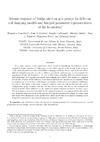Identificador persistente para citar o vincular este elemento:
https://accedacris.ulpgc.es/jspui/handle/10553/43144
| Título: | Seismic response of bridge piers on pile groups for different soil damping models and lumped parameter representations of the foundation | Autores/as: | González, Francisco Padrón, Luis A. Carbonari, Sandro Morici, Michele Aznárez, Juan J. Dezi, Francesca Leoni, Graziano |
Clasificación UNESCO: | 250618 Sedimentología 250705 Sismología y prospección sismica |
Palabras clave: | Biot's damping model Bridge seismic response Hysteretic dampipng model Pile foundations Soils-structure interaction |
Fecha de publicación: | 2019 | Proyectos: | Avances en El Desarrollo de Modelos Numéricos Para la Caracterización Dinámica de Cimentaciones Para Aerogeneradores Influencia de Los Fenómenos de Interacción Suelo-Estructura en la Respuesta Sísmica De |
Publicación seriada: | Earthquake Engineering and Structural Dynamics | Resumen: | This paper presents a wide parametric study aimed at elucidating the influence, on the computed seismic response of bridge piers, of two related aspects of the model: (1) the adoption of the classical hysteretic or the causal Biot's damping models for the soil and (2) the use of two different lumped parameter models of different complexity and accuracy to approximate the impedances of the pile foundation. A total of 2072 cases, including different superstructures, pile foundations, soil deposits, and seismic input signals, are studied. The results are presented so that the influence of the different parameters involved in the analysis can be assessed. From an engineering point of view, both lumped parameter models provide, in general, sufficiently low errors. The choice of the most adequate model for each case will depend not only on the configuration of the structure and the soil‐foundation system but also on the assumed soil damping model, whose influence on the computed seismic responses is relevant in many cases. The nonphysical behaviour provided by the classical hysteretic damping model for the soil at zero frequency generates issues in the process of fitting the impedance functions. It is also found that larger deck displacements are predicted by Biot's model due to the higher damping at low frequencies provided by the classical hysteretic damping model. | URI: | https://accedacris.ulpgc.es/handle/10553/43144 | ISSN: | 0098-8847 | DOI: | 10.1002/eqe.3137 | Fuente: | Earthquake Engineering and Structural Dynamics [ISSN 0098-8847], v. 48 (3), p. 306-327 |
| Colección: | Artículos |
Citas SCOPUSTM
25
actualizado el 08-jun-2025
Citas de WEB OF SCIENCETM
Citations
22
actualizado el 12-ene-2026
Visitas
79
actualizado el 11-ene-2026
Descargas
256
actualizado el 11-ene-2026
Google ScholarTM
Verifica
Altmetric
Comparte
Exporta metadatos
Los elementos en ULPGC accedaCRIS están protegidos por derechos de autor con todos los derechos reservados, a menos que se indique lo contrario.
